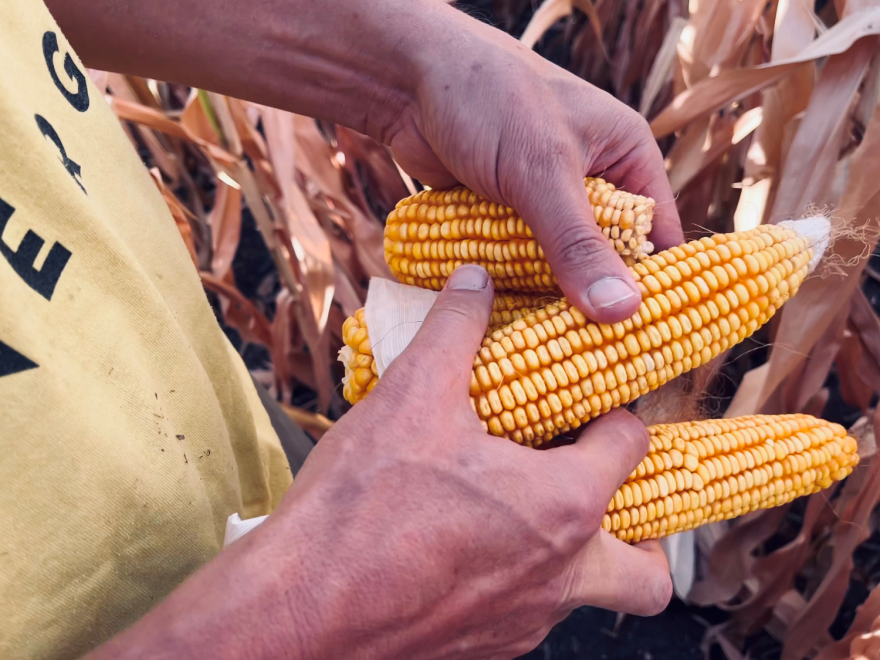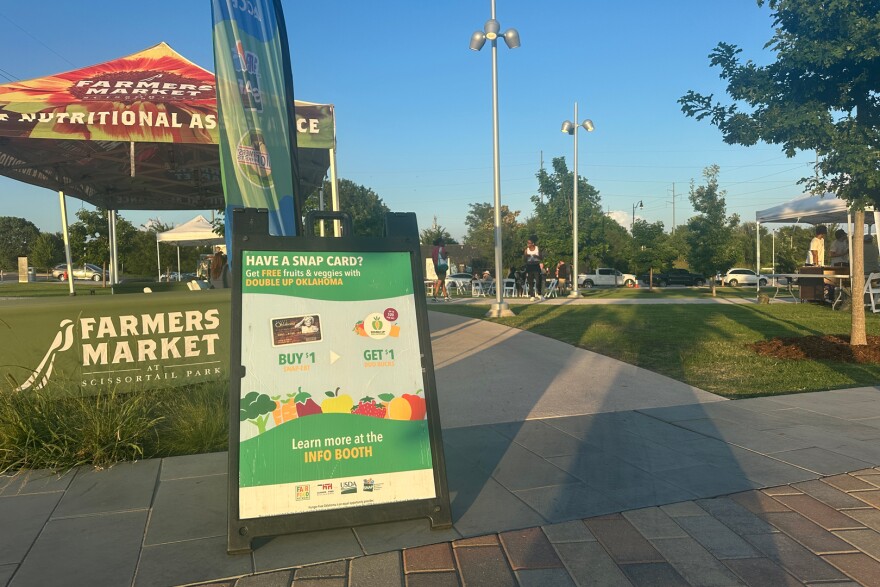For some farmers, the recently-passed “One Big Beautiful Bill Act” could bring more security. But for others, it may do the opposite.
The massive tax and spending law, which President Donald Trump signed at the beginning of the month, is expected to increase agricultural spending by nearly $66 billion over the next decade.
Over 80% of that slice will go toward programs that help farmers make up losses from natural disasters and when commodity prices and revenues dip below certain thresholds. It also extends tax cuts from 2017 and makes others permanent, like the estate tax exemption.
Many agriculture groups have applauded the law. American Farm Bureau Federation president Zippy Duvall stated in a news release that the changes will bring certainty for many farmers and ranchers.
“Modernizing important farm safety net programs and making permanent critical tax provisions could be the difference between staying in business or shutting down the family farm,” Duvall said. “Lawmakers took a big step toward ensuring America’s farmers and ranchers can continue to keep pantries filled for America’s families.”

Duane Stateler, National Pork Producers Council president, called the new law “one of the most consequential pieces of legislation for American agriculture in years.” He pointed to funding for animal disease prevention and management, and said the law “cuts red tape.”
But some farmer groups have raised red flags. National Farmers Union president Rob Larew stated the gains for agriculture “are paired with harmful tradeoffs.” Particularly, the bill slashes spending for the Supplemental Nutrition Assistance Program and Medicaid.
“Cuts to SNAP divide the farm bill coalition and reductions in Medicaid will have harmful effects on millions of Americans,” Larew said “Farm policy should unite us. This approach undermines the foundation of the farm bill and puts its future at risk.”
Mike Lavender, policy director of the National Sustainable Agriculture Coalition, described the law as “cannabilizing” the American food and farm system.
The legislation carves out nearly $186 billion from SNAP while subsidizing the largest, wealthiest farmers, he said.
“There's a subset of folks who benefit from this bill,” Lavender said. “It is not the majority of folks in the food and farm system.”
Cuts to SNAP will likely hurt specialty farmers
Commodities like corn, wheat and rice tend to rely on direct payments from the government when times get tough, said Chad Hart, Iowa State University Extension and Outreach economist.
Whereas specialty crops, like tomatoes and cabbage, rely more on market access support. That includes Double Up Food Bucks, a SNAP program in over 25 states. It provides a one-to-one match for participants to buy more fruits and vegetables at participating farmers markets and grocery stores, and through community-supported agriculture.
“With food assistance basically under the chopping block here, that means less support for [specialty farmers] in the long run,” said Hart.

In 2023, over 40,000 Iowans redeemed nearly $600,000 from the Double Up Food Bucks program. A third of that was spent at farmers markets in the state.
The Iowa Food System Coalition said the new law will result in “fewer fresh foods on the table for families and fewer customers and sales for local producers and outlets already navigating tight margins and a volatile farm economy.”
Commodity farmers get a jump
Agricultural Risk Coverage provides direct payments to farmers when their revenue from a specific crop falls below the historical average. Price Loss Coverage triggers a payment if the annual market price for a commodity drops under a set reference price.
The One Big Beautiful Bill Act extended the commodity programs through the 2031 crop year and increased reference prices for commodities by 10-21%. It also bumped up the revenue guarantee and maximum payment for the Agricultural Risk Coverage program.
The changes mark the largest increase in commodity support since 2002, said Ben Brown, an extension specialist in agricultural business and policy at the University of Missouri.
Brown said there’s often a debate in agricultural policy around the height of the safety net.
“Should it be right at the ground, or should it be right under the line, if you're a tight rope walker?” Brown said.
Brown said commodity groups were successful in advocating that the USDA’s payment rates were too low. He added that lawmakers shaping the new legislation weren’t bound by the same budget constraints as a farm bill, the traditional vehicle for moving food and agricultural policy in the U.S.
Lavender emphasized that the commodity payments benefit a subset of farmers. Only 27% of U.S. farm acres were enrolled in the Agricultural Risk Coverage and Price Loss Coverage programs in 2023.

The legislation increases the commodity program payment limits from $125,000 to $155,000 for “actively engaged” individuals and extends eligibility to members of partnerships, Limited Liability Companies and S corporations.
“It expands eligibility for farm payments to board members, to absent landowners, regardless of their labor or kind of contributions to the farm,” Lavender said.
It also removes a “means test” for those who earn at least 75% of their income from agriculture and related activities. Before, farm businesses with almost a million dollar profit margin were not eligible for most subsidies.
Lavender said the means test stemmed from a bipartisan belief that the wealthiest Americans did not need to be “bailed out by taxpayers.”
Conservation wins and losses
Lavender said a “bright spot” in the new law is conservation. His team estimates the legislation shifts an estimated $10 billion in unspent Inflation Reduction Act dollars for several long-standing agricultural conservation programs. It also increases their permanent baseline funding.
This includes the Conservation Stewardship Program, Environmental Quality Incentives Program, Agricultural Conservation Easement Program and Regional Conservation Partnership Program.
“It's positive from the standpoint that they're putting more funding into agricultural conservation programs,” Lavender said, “But they're also removing targeting that helps to prioritize some of the most popular, classic conservation practices that also just happen to be practices that help farmers build resilience and sequester carbon.”
Lavender pointed to Climate-Smart Agriculture and Forestry practices, which in part aim to reduce greenhouse gas emissions.
But he said it’s significant the new law did not extend one of the largest conservation programs in the country: the Conservation Reserve Program. It pays farmers to convert highly erodible and vulnerable land into wildlife habitat, typically for 10-15 years.
If Congress does not extend the 2018 farm bill or pass a new one, the U.S. Department of Agriculture will not be able to enroll new acres as contracts expire after Sept. 30.

Where do these measures put a new farm bill?
Other farm bill programs related to rural development, horticulture and forestry were also left out of the tax and spending law. The big question now is whether Congress will still try to pass a “skinny farm bill” this fall, said Hart.
“The passage of the big beautiful bill takes off a lot of the pressure, because it does extend these commodity title programs,” Hart said. And that's what brings groups like Farm Bureau and National Corn Growers and American Soybean Association in to talk to Congress.”
The 2018 Farm Bill was set to expire in 2023. Congress has extended it twice rather than pass a new one.
Whether lawmakers will pass more agricultural and nutrition policies outside the farm bill is the “billion dollar question,” said Lavender.
“I think what we're seeing is lawmakers not wanting to negotiate,” Lavender said. “They're looking for pathways to enact strictly partisan legislation through reconciliation, and Democrats have used reconciliation, too. That's what the Inflation Reduction Act was,” Lavender said.
Adding to the deficit puts USDA programs at risk
The Congressional Budget Office estimates the One Big Beautiful Bill Act will add $3.4 trillion to the national debt over the next ten years.
The Statutory Pay-As-You-Go Act of 2010 prevents “new revenue and mandatory spending legislation enacted during a session of Congress from increasing the net deficit.”
“It says that if Congress is going to pass a law that increases the deficit by X amount, they also need to pass a law that decreases the deficit by that same X amount,” Lavender said.
Congress has authority to waive the rule, but if it doesn’t do this by the end of the year, Lavender said funding for dozens of federal programs would be slashed. Under the USDA alone, this includes:
- National Institute of Food and Agriculture
- Agricultural Research Service
- Animal and Plant Health Inspection Service
- Agricultural Marketing Service
- Risk Management Agency
- Farm Service Agency
- Natural Resources Conservation Service
- Food and Nutrition Service
“It’s tremendously significant,” Lavender said.
This story was produced in partnership with Harvest Public Media, a collaboration of public media newsrooms in the Midwest and Great Plains. It reports on food systems, agriculture and rural issues.





